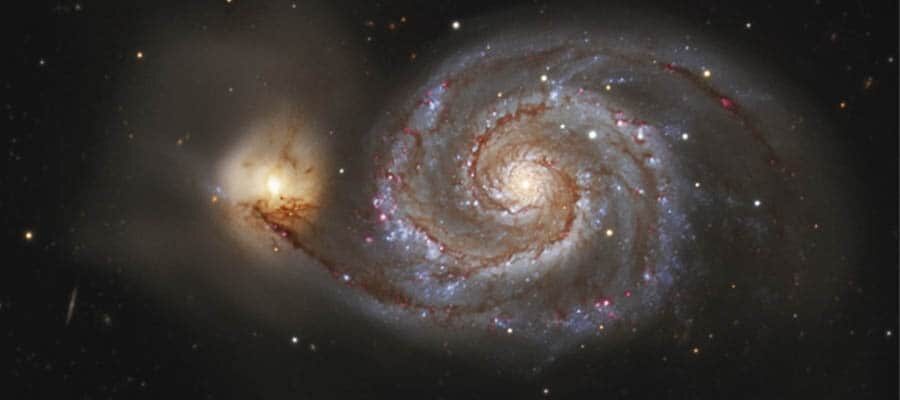10 Whirlpool Galaxy Facts
The Whirlpool galaxy is also referred to as M51a, and it’s a great place for amateur astronomers to start when they’re first looking up in the night sky. It is pretty easy to locate in comparison to the other galaxies in our night sky, and you don’t need much more than a cheap telescope to see it. Let’s check out some great facts about the Whirlpool galaxy.
- The Whirlpool galaxy has a radius of 30,000 light years. This makes it very similar in size to the Black Eye galaxy, and slightly smaller than our galaxy, the Milky Way.
- It makes up part of the M52 group – it is the largest galaxy in this group, which also includes the Sunflower galaxy.
- There is around 23 million light years between the Whirlpool galaxy and our planet, Earth.
- The mass of the Whirlpool galaxy is estimated to be 160 million M☉ (160 million solar masses).
- You’ll often see the Whirlpool galaxy referred to as M51a. M52b is actually another small companion galaxy of the Whirlpool galaxy called NGC 5195 – this is the reason the arms of the Whirlpool galaxy are warped.
- These two galaxies are actually connected by a tidal bridge made out of dust.
- The grand spiral structure of this galaxy is likely a result of its close relationship with NGC 5195. We think this might have had an effect on the high star production volume of this galaxy.
- The Whirlpool galaxy was discovered by french astronomer Charles Messier in 1781. He was a close associate of Pierre Mechain, who later discovered the companion galaxy. Charles later featured the Whirlpool in the Messier catalog.
- It also has a supermassive black hole at the center of its spiral, like most other large galaxies do.
- This galaxy is actually located within the constellation Canes Venatici, which means that it’s quite easy to locate in the sky.
- The Whirlpool galaxy has a very fast rate of star formation. This is due to its collision with a smaller galaxy, which has essentially merged the two together.

As you’ve probably guessed by its appearance, the Whirlpool galaxy is actually a type of spiral galaxy. It was actually the first galaxy to be identified as a spiral type, so in many astronomers eyes it is the best example of a grand design spiral galaxy.
Most people credit Messier with discovering the Whirlpool galaxy, and it is true that he discovered the main Whirlpool galaxy. However, the companion galaxy to Whirlpool was later discovered by French astronomer Pierre Mechain, who sent his findings to Messier. However, it wasn’t until 1845 that Irish astronomer William Parsons discovered that the Whirlpool had a very distinct spiral structure.
If you’re trying to see the Whirlpool galaxy in the night sky, then your best bet is to look for the Canes Venatici constellation. It is located to the North West of the main part of the constellation, above the Sunflower galaxy.
Like virtually all other large galaxies, at the center of the Whirlpool is a supermassive black hole. At its center is a unique skeletal dust structure.
Many people wonder whether the Whirlpool galaxy is actually bigger than our own galaxy, this Milky Way. The answer is that it’s not – it’s actually less than half the size of our galaxy (43% of the size to be exact).
All in all, the Whirlpool galaxy is a great example of a spiral galaxy – of course, it takes it’s name from it’s spiralling Whirlpool-like appearance. This wasn’t noticed originally upon discovery, but now with the Hubble telescope we can get a great view of the center of this amazing galaxy.